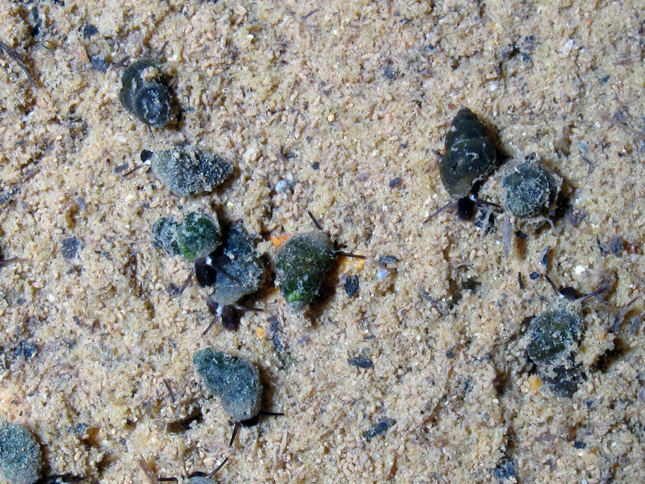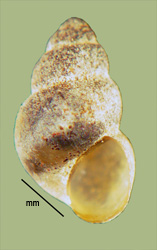Pyrgulopsis ogmorhaphe or ogmorphaphe
> Habitat & Distribution
Pilsbry described this species from the Big Spring in "Huntsville, Alabama," from which it is now extinct. Subsequently Thompson discovered populations in Blue Spring, about 2 miles east of Huntsville, and in lower Limestone Creek, about 20 miles west. It now seems likely that populations described as Marstonia ogmorhaphe from Marion County, TN, are best identified as M. olivacea as well. Their habitat preference seems to be a flocculent mud bottom in marginal backwaters and quiet pools (US Fish & Wildlife Service, 1995).
Marstonia olivacea was listed (as "Marstonia ogmorhaphe") as "endangered" by the US Fish and Wildlife Service on 04-15-1994 (USFWS 1994, 1995). FWGNA incidence rank I-1, rare.
> Ecology & Life History
Hydrobiids seem to be rather nonspecific grazers of small particles (Dillon 2000: 94-97). They are typically dioecious, the males being characterized by a penis that arises from the neck. Females attach single eggs in spare, hemispherical capsules to solid substrates (Hershler 1994). No specific life history data are as yet available for M. olivacea.
> Taxonomy & Systematics
Like Spilochlamys, Notogillia, and Floridobia, the genus Marstonia belongs to the subfamily Nymphophilinae of the Hydrobiidae (ss), males being characterized by a lobe-shaped penis (or verge) with surficial glandular patterns (Kabat and Hershler 1993, Hershler et al. 2003, Thompson 2004). The male reproductive system of M. ogmorhaphe was figured by Thompson (1977).
Baker (1926) originally proposed Marstonia as a subgenus of Amnicola. Thompson (1969, 1977) redefined and expanded the taxon, placing several newly-described southeastern species in it. Hershler and Thompson (1987) synonymized Marstonia under Pyrgulopsis on the basis of similarities in penial morphology. But after review of female reproductive anatomy, Thompson and Hershler (2002) resurrected Marstonia to generic status and allocated to it all eastern North American species previously placed in Pyrgulopsis. Female reproductive anatomy, specifically occurrence of a large extension of the albumen gland into the pallial roof, is a distinctly Marstonia characteristic (Hershler 1994, Hershler et al. 2003). Recent molecular-based phylogenetic analyses has also supported the distinction between Marstonia and Pyrgulopsis (Liu and Hershler 2005), and the retention of both genera in the Hydrobiidae sensu strictu (Wilke et al. 2013).
Pilsbry's original (1895) description of M. olivacea was unfigured and published without anatomical observations. Figures of the shell, operculum and radula were contributed by Thompson (1977) and Hershler (1994), although again with no anatomical observations. Thompson did, however, offer several nice figures of both male and female reproductive systems in his description of M. ogmorhaphe. See my essay of 19Sept23 from the link below for more about our suggestion that Thompson's ogmorhaphe be synonymized under Pilsbry's olivacea.
Thompson himself spelled the specific nomen with two
pees, "ogmorphaphe,"
at
the heading of his 1977 description (pg 120), but just the single pee "ogmorhaphe" enough
times subsequently to make the one-pee spelling stick.
Interestingly, Thompson spelled it with an aye, "ogmorhapha" in
his table of contents (page 114).
> Maps and Supplementary Resources
- Marstonia distribution in the Tennessee/Cumberland (2022)
- Cute Facebook video from our friends at The Tennessee Department of Environment and Conservation: Royal Marstonia Snail. "Be careful around the tiny snails when you visit!"
- Photo of M.
olivacea on flocculent substrate in Owen Spring Run,
courtesy of Alan Cressler.

> Essays
- See my essay of 19Sept23, Is Marstonia olivacea extinct?, for a review of the extensive (and tangled) history of this enigmatic hydrobiid. That post also features several nice figures of the shell and a distribution map.
- Earlier versions of this website, online until August of 2016, adopted the large, broadly-inclusive concept of the Hydrobiidae (sl) following Kabat & Hershler (1993). More recently the FWGNA project has shifted to the Wilke et al. (2013) classification system, distinguishing a much smaller Hydrobiidae (ss) and elevating many hydrobioid taxa previously ranked as subfamilies to the full family level. For more details, see The Classification of the Hydrobioids.
> References
Baker, F.C. (1926)
Nomenclatural notes on American fresh water Mollusca. Transactions of
the Wisconsin Academy of Sciences, Arts, and Letters 22:193-205.
Dillon, R.T., Jr. (2000)
The Ecology of Freshwater Molluscs. Cambridge University Press,
Cambridge, United Kingdom.
Hershler, R. (1994)
A review of the North American freshwater snail genus Pyrgulopsis
(Hydrobiidae). Smithsonian Contributions to Zoology
554:1-115.
Hershler, R., H. Liu, and
F.G. Thompson (2003)
Phylogenetic relationships of North American nymphophiline gastropods
based on mitochondrial DNA sequences. Zoologica Scripta
32:357-366.
Hershler, R., and F.G.
Thompson (1987) North American Hydrobiidae
(Gastropoda: Rissoacea): redescription and systematic relationships of Tryonia Stimpson,
1865 and Pyrgulopsis
Call and Pilsbry, 1886. The Nautilus
101:25-32.
Kabat, A.R., and R.
Hershler (1993)
The prosobranch snail family Hydrobiidae (Gastropoda: Rissooidea):
review of classification and supraspecific taxa. Smithsonian
Contributions to Zoology 547:1-94.
Liu, H., and R. Hershler
(2005)
Molecular systematics and radiation of western North American
nympholine gastropods. Molecular Phylogenetics and Evolution
34:284-298.
Pilsbry, H.A. (1895)
New American fresh-water mollusks. Nautilus 8: 114 116.
Thompson, F.G. (1968)
The
Aquatic Snails of the Family Hydrobiidae of Peninsular Florida.
University of Florida Press, Gainesville, Florida,
USA.
Thompson, F.G. (1969)
Some hydrobiid snails from Georgia and Florida. Quarterly Journal of
the Florida Academy of Sciences 32:241-265.
Thompson, F.G. (1977)
The hydrobiid snail genus Marstonia.
Bulletin of the Florida State Museum 21(3):113-158.
Thompson, F.G. (2004)
An identification manual for the freshwater snails of
Florida.
Thompson, F. G. &
R. Hershler (2002) Two genera of North American
freshwater snails: Marstonia
Baker, 1926, resurrected to generic status, and Floridobia, new
genus (Prosobranchia: Hydrobiidae: Nymphophilinae). The
Veliger 45: 269 - 271.
US Fish &
Wildlife Service (1994)
ETWP: Determination of Endangered Status for the Royal Snail and
Anthony's Riversnail. Federal Register 59(73):17994-17998.
US Fish &
Wildlife Service (1995) Royal Snail Recovery
Plan. Atlanta, GA. 20 pp.
Wilke T., Haase M., Hershler R.,
Liu H-P., Misof
B., Ponder W. (2013)
Pushing short DNA
fragments to the limit: Phylogenetic relationships of hydrobioid
gastropods
(Caenogastropoda: Rissooidea). Molecular
Phylogenetics and Evolution 66: 715 736.








